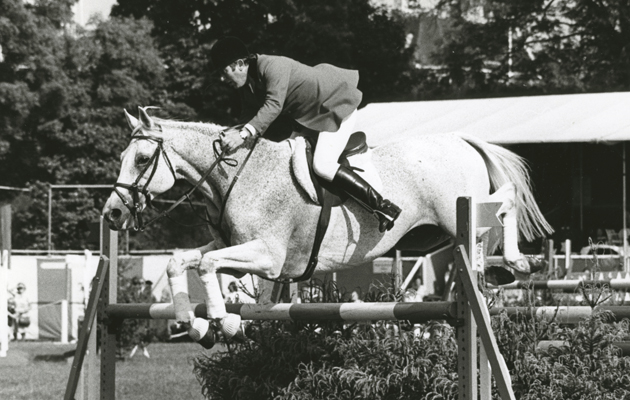One of the first female Olympic medallists in eventing, Ginny Elliot also claimed three consecutive European titles and multiple wins at Badminton and Burghley to earn her place among the sport’s greats, discovers Andrea Oakes
Few have ridden across country with the panache of Ginny Elliot, the petite eventer whose distinctive purple colours blazed a trail around the sport’s toughest tracks. Yet Ginny delivered not just style, but substance.
During an astonishing decade, she dominated the international scene – claiming multiple Olympic, World and European Championship medals alongside a Badminton hat-trick and five Burghley wins. “We hit a real purple patch in the 1980s,” she recalls. “I’d had a tough time but, thankfully, everything suddenly clicked.”
She certainly made it look effortless. Fellow eventers admired her, spectators adored her and no pony-mad youngster’s bedroom was complete without posters of Priceless, Night Cap and Master Craftsman on the walls. But the polished performances came after an arduous climb to the top.
{"content":"PHA+R2lubnksIHdob3NlIG1haWRlbiBuYW1lIHdhcyBIb2xnYXRlIGFuZCBmaXJzdCBtYXJyaWVkIG5hbWUgd2FzIExlbmcsIHdhcyBib3JuIGluIE1hbHRhLCBpbiAxOTU1LiBIZXIgZmF0aGVyIHdhcyBhIFJveWFsIE1hcmluZSBzbyBzaGUgc3BlbnQgbXVjaCBvZiBoZXIgY2hpbGRob29kIGFicm9hZCwgd2l0aCBzcGVsbHMgYXQgc2Nob29sIGluIHRoZSBVSy48L3A+CjxwPuKAnE15IGludGVyZXN0IGluIGhvcnNlcyBncmV3IGZyb20gbXkgbW90aGVyIFtIZWF0aGVyXeKAmXMgc2lkZSwgYXMgc2hlIGFuZCBteSBncmFuZGZhdGhlciBbRXdhcnQgUmljZV0gaGFkIGFsd2F5cyBiZWVuIGludG8gc2hvd2luZyBhbmQgcG9sbyzigJ0gZXhwbGFpbnMgR2lubnksIHdobyBzdGFydGVkIHJpZGluZyBhdCB0aHJlZSBhbmQgd2hvc2UgZmlyc3QgcHJvcGVyIHBvbnkgd2FzIGEgV2Vsc2ggTW91bnRhaW4gbWFyZSBjYWxsZWQgTWlzdHkuIOKAnEdyYW5kcGEgaGFkIGEgcGFzc2lvbiBmb3IgYnV5aW5nIGhvcnNlcy4gT25lIGRheSBoZSBhcnJpdmVkIHdpdGggYSBmb2FsIGhlIGhhZCBib3VnaHQgZm9yIG1lLCBmb3IgwqMzNSwgZnJvbSBGaXZlIExhbmVzIENhdHRsZSBNYXJrZXQgaW4gQ29ybndhbGwu4oCdPC9wPgo8cD48ZGl2IGNsYXNzPSJhZC1jb250YWluZXIgYWQtY29udGFpbmVyLS1tb2JpbGUiPjxkaXYgaWQ9InBvc3QtaW5saW5lLTIiIGNsYXNzPSJpcGMtYWR2ZXJ0Ij48L2Rpdj48L2Rpdj48c2VjdGlvbiBpZD0iZW1iZWRfY29kZS0zMSIgY2xhc3M9ImhpZGRlbi1tZCBoaWRkZW4tbGcgcy1jb250YWluZXIgc3RpY2t5LWFuY2hvciBoaWRlLXdpZGdldC10aXRsZSB3aWRnZXRfZW1iZWRfY29kZSBwcmVtaXVtX2lubGluZV8yIj48c2VjdGlvbiBjbGFzcz0icy1jb250YWluZXIgbGlzdGluZy0tc2luZ2xlIGxpc3RpbmctLXNpbmdsZS1zaGFyZXRocm91Z2ggaW1hZ2UtYXNwZWN0LWxhbmRzY2FwZSBkZWZhdWx0IHNoYXJldGhyb3VnaC1hZCBzaGFyZXRocm91Z2gtYWQtaGlkZGVuIj4NCiAgPGRpdiBjbGFzcz0icy1jb250YWluZXJfX2lubmVyIj4NCiAgICA8dWw+DQogICAgICA8bGkgaWQ9Im5hdGl2ZS1jb250ZW50LW1vYmlsZSIgY2xhc3M9Imxpc3RpbmctaXRlbSI+DQogICAgICA8L2xpPg0KICAgIDwvdWw+DQogIDwvZGl2Pg0KPC9zZWN0aW9uPjwvc2VjdGlvbj48L3A+CjxwPlRoZSBjb2x0LCBjaHJpc3RlbmVkIER1Ym9ubmV0LCB3b3VsZCBwbGF5IGEgcGl2b3RhbCByb2xlIGluIEdpbm554oCZcyBzdWNjZXNzLjwvcD4KPHA+4oCcV2hlbiDigJhEdWJieeKAmSB3YXMgZml2ZSwgSSB3b3VsZCBoYWNrIGhpbSBvdmVyIGZvciBsZXNzb25zIHdpdGggU2FsbHkgU3RyYWNoYW4gW2VsZGVyIHNpc3RlciBvZiBldmVudGVyIENsYXJpc3NhXSzigJ0gcmVjYWxscyBHaW5ueS4g4oCcSGUgd2FzIG9ubHkgMTUuMmhoLCBidXQgd2Ugd2VyZSBleGNpdGVkIHRvIGRpc2NvdmVyIHRoYXQgaGUgd2FzIGJ5IHRoZSBzYW1lIHNpcmUgYXMgTWFyeSBHb3Jkb24tV2F0c29u4oCZcyBncmVhdCBDb3JuaXNobWFuIFYuIEkganVzdCBpbWFnaW5lZCB0aGF0IER1YmJ5IHdvdWxkIGJlIHRoZSBzYW1lLuKAnTwvcD4KPHA+RGVzcGl0ZSBlYXJseSBlbGltaW5hdGlvbnMgYW5kIG1hbnkgcm9va2llIG1pc3Rha2VzLCBzaGUgYW5kIER1YmJ5IHByb2dyZXNzZWQgZnJvbSBQb255IENsdWIgdGVhbXMgdG8gYmVjb21lIGp1bmlvciBFdXJvcGVhbiBjaGFtcGlvbnMg4oCTIGV2ZW4gdGFraW5nIGEgdGlsdCBhdCB0aGVpciBmaXJzdCBCYWRtaW50b24sIGluIDE5NzQuIEdpbm55IGRldmVsb3BlZCBhIHNtYWxsIHN0cmluZyBhbmQgd2FzIGxvbmctbGlzdGVkIGZvciB0aGUgTW9udHJlYWwgT2x5bXBpY3Mgd2l0aCBhIHByb21pc2luZyB5b3VuZ3N0ZXIgY2FsbGVkIEphc29uLjwvcD4KPGRpdiBjbGFzcz0iYWQtY29udGFpbmVyIGFkLWNvbnRhaW5lci0tbW9iaWxlIj48ZGl2IGlkPSJwb3N0LWlubGluZS0zIiBjbGFzcz0iaXBjLWFkdmVydCI+PC9kaXY+PC9kaXY+CjxwPkJ1dCBoZXIgcGxhbnMgY2FtZSB0byBhIHNodWRkZXJpbmcgaGFsdCBzb29uIGFmdGVyIGhlciAyMXN0IGJpcnRoZGF5LCB3aGVuIHNoZSBicm9rZSBoZXIgbGVmdCBhcm0gaW4gMjMgcGxhY2VzIGluIGEgZmFsbCB3aXRoIEphc29uIGF0IGEgb25lLWRheSBldmVudC4gVGhhbmtzIHRvIHRoZSBza2lsbCBvZiBhIHRhbGVudGVkIHN1cmdlb24sIHRoZSBqaWdzYXcgb2YgYm9uZSBmcmFnbWVudHMgd2FzIHBpZWNlZCBiYWNrIHRvZ2V0aGVyIGFuZCBHaW5ueeKAmXMgYXJtIHdhcyBzYXZlZCBmcm9tIGFtcHV0YXRpb24uPC9wPgo8aDM+4oCYV2UgaGFkIG5vIG1vbmV54oCZPC9oMz4KPHA+R2lubnkgd2FzIGJhY2sgaW4gYWN0aW9uIGF0IEJ1cmdobGV5IGxhdGVyIHRoYXQgeWVhciB3aXRoIHVwLWFuZC1jb21pbmcgc3RhciBUaW8gUGVwZSwgYnV0IGZhY2VkIGJpZ2dlciBodXJkbGVzIG9uIHRoZSBwYXRoIHRvIHN1Y2Nlc3MuPC9wPgo8ZGl2IGNsYXNzPSJhZC1jb250YWluZXIgYWQtY29udGFpbmVyLS1tb2JpbGUiPjxkaXYgaWQ9InBvc3QtaW5saW5lLTQiIGNsYXNzPSJpcGMtYWR2ZXJ0Ij48L2Rpdj48L2Rpdj4KPHA+4oCcTXkgcG9vciBkYWQgaGFkIGRldmVsb3BlZCBtdWx0aXBsZSBzY2xlcm9zaXMgYW5kIHdlIGhhZCBubyBtb25leSzigJ0gc2hlIHNheXMuIOKAnE11bSBzYWlkIHdlIHdvdWxkIGhhdmUgdG8gZmluZCBhIHdheSwgc28gd2UgYm91Z2h0IGFuZCBzb2xkIGhvcnNlcyB0byBtYWtlIGVuZHMgbWVldC4gRXZlcnkgd2Vlaywgd2UgYmFnZ2VkIHVwIHNhY2tzIG9mIHNoYXZpbmdzIGF0IGEgc2F3bWlsbCwgYmVjYXVzZSB0aGV5IHdlcmUgZnJlZS4gV2UgaGFkIHRvIHNjcmltcCBhbmQgc2F2ZS48L3A+CjxwPuKAnE11bSBzZW50IG1lIHRvIFBhdCBNYW5uaW5nIGZvciBsZXNzb25zIGFuZCBJIHdvdWxkIGxpdmUgaW4gYSBjYXJhdmFuLCBtdWNraW5nIG91dCAyMiBib3hlcyBpbiByZXR1cm4gZm9yIGEgb25lLWhvdXIgbGVzc29uLOKAnSBHaW5ueSByZWNhbGxzLiDigJxJdCBnYXZlIG1lIHRoZSBvcHBvcnR1bml0eSB0byBkZWNpZGUgd2hldGhlciBJIHJlYWxseSB3YW50ZWQgdG8gZG8gdGhpcyBvciBub3Qu4oCdPC9wPgo8ZGl2IGNsYXNzPSJhZC1jb250YWluZXIgYWQtY29udGFpbmVyLS1tb2JpbGUiPjxkaXYgaWQ9InBvc3QtaW5saW5lLTUiIGNsYXNzPSJpcGMtYWR2ZXJ0Ij48L2Rpdj48L2Rpdj4KPHA+RGlzYXBwb2ludG1lbnRzIGNhbWUgdGhpY2sgYW5kIGZhc3QsIGhvd2V2ZXIsIGFzIGFsbCB0aHJlZSBvZiBoZXIgYWR2YW5jZWQgaG9yc2VzIHdlcmUgZm9yY2VkIGludG8gZWFybHkgcmV0aXJlbWVudCB3aXRoIGhlYWx0aCBpc3N1ZXMuIEdpbm55IGFkbWl0cyB0aGF0IHNoZSB3YXMgY2xvc2UgdG8gZ2l2aW5nIHVwIHdoZW4gc2hlIHN0YXJ0ZWQgc2Nob29saW5nIFByaWNlbGVzcyBhbmQgTmlnaHQgQ2FwLCB0d28gZml2ZS15ZWFyLW9sZCBCZW4gRmFlcmllIHNvbnMgYm91Z2h0IGxvY2FsbHkgaW4gRGV2b24uIEFzIHRoZXkgc3RhcnRlZCB0byBtYWtlIHRoZWlyIG1hcmssIHNoZSBzZXQgYWJvdXQgc2VjdXJpbmcgZmluYW5jaWFsIHN1cHBvcnQuPC9wPgo8cD7igJxJIHdvdWxkIGdvIHVwIHRvIExvbmRvbiBvbiB0aGUgdHJhaW4gb25jZSBhIHdlZWsgdG8gdHJ5IHRvIGZpbmQgYSBzcG9uc29yLOKAnSBzYXlzIEdpbm55LCB3aG9zZSBlZmZvcnRzIGV2ZW50dWFsbHkgcGFpZCBvZmYgd2l0aCBiYWNraW5nIGZyb20gQnJpdGlzaCBOYXRpb25hbCBMaWZlIEFzc3VyYW5jZS4g4oCcSeKAmW0gbm90IHBhcnRpY3VsYXJseSBjb21wZXRpdGl2ZSwgYnV0IEkgYW0gZGV0ZXJtaW5lZC7igJ08L3A+CjxwPkFuZCBzbyBiZWdhbiB0aGF0IGV4dHJhb3JkaW5hcnkgcnVuIG9mIHJlc3VsdHMsIHdoZW4sIGFzIEdpbm55IGV4cGxhaW5zLCDigJxldmVyeXRoaW5nIHdlbnQgcmlnaHTigJ0uIFByaWNlbGVzcyBsZWQgdGhlIGNoYXJnZSwgZGVmeWluZyB0aGUgY3JpdGljcyB3aG8gY2xhaW1lZCBoZSB3YXMgdG9vIGNvbW1vbiBieSBiYWNraW5nIHVwIHdvcmxkIGFuZCBFdXJvcGVhbiB0ZWFtIGdvbGRzIHdpdGggYSB3aW4gYXQgQnVyZ2hsZXkgaW4gMTk4My48L3A+CjxwPkdpbm55IGJlY2FtZSBFdXJvcGVhbiBjaGFtcGlvbiB0aHJlZSB0aW1lcyBpbiBhIHJvdyDigJMgaW4gMTk4NSB3aXRoIFByaWNlbGVzcywgaW4gMTk4NyB3aXRoIE5pZ2h0IENhcCBhbmQgaW4gMTk4OSB3aXRoIE1hc3RlciBDcmFmdHNtYW4uIFNoZSBjbGluY2hlZCBXb3JsZCBDaGFtcGlvbnNoaXAgZ29sZCBpbiBHYXdsZXIgaW4gMTk4Niwgd2l0aCBQcmljZWxlc3MsIGJlZm9yZSByaWRpbmcgTmlnaHQgQ2FwIHRvIHZpY3RvcnkgYXQgdGhlIGFsdGVybmF0aXZlIHdvcmxkcyBsYXRlciB0aGF0IHllYXIgKGxhaWQgb24gYXQgQmlhbHkgQm9yLCBQb2xhbmQsIGJlY2F1c2UgbWFueSBuYXRpb25zIGNvdWxkbuKAmXQgdHJhdmVsIHRvIEF1c3RyYWxpYSkuPC9wPgo8cD5HaW5ueSBhbHNvIGNsYWltZWQgaW5kaXZpZHVhbCBicm9uemUgYW5kIHRlYW0gc2lsdmVyIE9seW1waWMgbWVkYWxzIHdpdGggUHJpY2VsZXNzIGluIExvcyBBbmdlbGVzIGluIDE5ODQsIGFjaGlldmluZyB0aGUgc2FtZSB3aXRoIE1hc3RlciBDcmFmdHNtYW4gaW4gU2VvdWwgaW4gMTk4OC4gU2xvdHRlZCBiZXR3ZWVuIHdlcmUgYWRkaXRpb25hbCBCYWRtaW50b24gYW5kIEJ1cmdobGV5IHdpbnMg4oCTIE1hc3RlciBDcmFmdHNtYW4gdG9vayBib3RoIHRpdGxlcyBpbiAxOTg5LCBmb3VyIHllYXJzIGFmdGVyIFByaWNlbGVzcyBoYWQgYWNoaWV2ZWQgdGhlIHNhbWUgZmVhdC48L3A+CjxwPuKAnEkgcmVhbGx5IHJlc3BlY3RlZCBob3cgd29uZGVyZnVsIHRoZSBob3JzZXMgd2VyZSBpbiB0aG9zZSB5ZWFycyzigJ0gc2F5cyBHaW5ueS4g4oCcSSBsaWtlIHRvIHRoaW5rIHRoZXkgdHJ1c3RlZCB1cy4gSSB1c2VkIGEgdHJhaW5pbmcgZXRoaWMgdGF1Z2h0IHRvIG1lIGJ5IExhZHkgSHVnaCBSdXNzZWxsIGFuZCBQYXQgTWFubmluZywgYW5kIHdlIHdlbnQgdG8gc29tZSBsZW5ndGhzIHRvIHByZXBhcmUgdGhlbSDigJMgdHVybmluZyB0aGVtIG91dCBldmVyeSBkYXksIGluY29ycG9yYXRpbmcgcm9hZHdvcmssIGhpbGx3b3JrIGFuZCBnYWxsb3BzIGludG8gdGhlaXIgcm91dGluZSwgYnV0IG5ldmVyIHVzaW5nIGdhZGdldHMuPC9wPgo8cD7igJxJIGJlZ2dlZCByYWNlaG9yc2UgdHJhaW5lciBNaWNoYWVsIERpY2tpbnNvbiB0byBzaG93IG1lIGhvdyB0byBnZXQgdGhlbSByZWFsbHkgZml0LCBoZWxwaW5nIGhpbSBpbiByZXR1cm4gd2l0aCBzb21lIGdyaWR3b3JrIGZvciBoaXMgcmFjZWhvcnNlcy48L3A+CjxwPuKAnEkgd2FzIGluY3JlZGlibHkgZm9ydHVuYXRlIHdpdGggbXkgdGVhbSzigJ0gYWRkcyBHaW5ueSwgd2hvIGhhZCBidWlsdCBhIGZvcm1pZGFibGUgYmFjay11cCBjcmV3IHRoYXQgaW5jbHVkZWQgSGVhdGhlciBhbmQgRG90IFdpbGxpcyAoUGF0IE1hbm5pbmfigJlzIGZvcm1lciBoZWFkIGdpcmwpLCB3aXRoIHNob3dqdW1waW5nIGlucHV0IGZyb20gdHJhaW5lciBQYXQgQnVyZ2Vzcy4g4oCcRXZlcnlvbmUgcGFpZCBhdHRlbnRpb24gdG8gZGV0YWlsLiBJdOKAmXMgbGlrZSBhIEZvcm11bGEgT25lIGRyaXZlciB3aXRoIHRoZSBtZWNoYW5pY3Mg4oCTIHlvdSBjYW7igJl0IHdpbiB3aXRob3V0IHRoZW0u4oCdPC9wPgo8cD5HaW5ueSBpcyBxdWljayB0byBjcmVkaXQgdGhlIGxpa2VzIG9mIE1hcmsgVG9kZCBhbmQgTHVjaW5kYSBHcmVlbiBmb3IgdGhlIGhlbHAgc2hlIHJlY2VpdmVkIG9uIHRoZSB3YXksIHNheWluZzog4oCcSSBsb3ZlIGFza2luZyBxdWVzdGlvbnMuIEkgYXNrZWQgbG90cyBvZiB0aG9zZSBhdCB0aGUgdG9wIG9mIHRoZWlyIGdhbWUgYW5kIHRoZXkgYWxsIG1hbmFnZWQgdG8gcHV0IHVwIHdpdGggbWUu4oCdPC9wPgo8aDM+VGhlIHdvcmxkIHN0YWdlPC9oMz4KPHA+SnVzdCBhcyBzaGUgaGFkIHN0dWRpZWQgaGVyIGhlcm9lcywgYWxsIGV5ZXMgd2VyZSBvbiBHaW5ueSBhcyBzaGUgZXN0YWJsaXNoZWQgaGVyc2VsZiBvbiB0aGUgd29ybGQgc3RhZ2UuIEhlciBwcmVwYXJhdGlvbiB3YXMgc2Vjb25kIHRvIG5vbmUuPC9wPgo8cD7igJxJIGxpa2UgZG9pbmcgdGhpbmdzIHByb3Blcmx5IGFuZCBoYXRlIG1ha2luZyBtaXN0YWtlcywgc28gSSB3b3VsZCBkb3VibGUtY2hlY2sgZXZlcnl0aGluZyzigJ0gc2hlIHNheXMuIOKAnEkgdXNlZCB0byBnZXQgcHJldHR5IG5lcnZvdXMuIEV2ZXJ5b25lIGVsc2Ugd2FzIGFzIGNvb2wgYXMgYSBjdWN1bWJlcjsgTWFyeSBLaW5nIGFsd2F5cyBzZWVtZWQgc28gY2FsbS4gSSB3YXMgZW52aW91cyE8L3A+CjxwPuKAnFRoZSB3b3JzdCB0aGluZyB3YXMgd2FraW5nIHVwIG9uIGNyb3NzLWNvdW50cnkgZGF5IHRvIHRoZSBzb3VuZCBvZiByYWluIGZhbGxpbmcgb24gdGhlIGNhcmF2YW4gcm9vZiwgYW5kIHRoaW5raW5nLCDigJhJIHdpc2ggSSB3YXNu4oCZdCBoZXJlLOKAmeKAnSBzaGUgYWRkcy4g4oCcQnV0LCBhcyBzb29uIGFzIHRoZSBzdGFydGVyIHNhaWQsIOKAmEdvLOKAmSBJIHdhcyBmaW5lLiBBbGwgdGhvc2UgaG9ycmlibGUgZmVlbGluZ3MganVzdCBkaXNhcHBlYXJlZC7igJ08L3A+CjxwPkdpbm55IHJlbWVtYmVycyBjb21pbmcgdG8gdGVybXMgd2l0aCBoZXIgZmFtZSB3aXRoIGEgc21pbGUuIOKAnEF0IEJhZG1pbnRvbiwgaW4gMTk4NSwgaXQgd2FzIGFubm91bmNlZCBvbiB0aGUgdGFubm95IHRoYXQgSeKAmWQgZmluaXNoZWQgdGhlIGNyb3NzLWNvdW50cnkgaW4gdGhlIGxlYWQuIFdlIHBhY2tlZCB0aGUgMTAtbWludXRlIGhhbHQgc3R1ZmYgW2xvbmctZm9ybWF0IGV2ZW50aW5nXSBpbnRvIHRoZSBjYXIgYW5kIEkgd2FzIHNpdHRpbmcgaW4gdGhlIGJhY2sgd2l0aCBteSBncmVhdCBmcmllbmQgTG91aXNlIEJhdGVzIHdoaWxlIG11bSBkcm92ZS48L3A+CjxwPuKAnEFzIHdlIGZvdWdodCB0aHJvdWdoIHRoZSBjcm93ZHMsIEkgbm90aWNlZCB0aGF0IGV2ZXJ5b25lIHdhcyB3YXZpbmcgYXQgbWUuIOKAmEFtYXppbmcs4oCZIEkgdGhvdWdodCwg4oCYV2XigJl2ZSByZWFsbHkgbWFkZSBpdCHigJkgVGhlbiBhIG1hbiB0YXBwZWQgb24gdGhlIHdpbmRvdyBhbmQgc2FpZCDigJhXZeKAmXJlIG5vdCB3YXZpbmcgYXQgeW91LCB5b3UgcHJhdCDigJMgeW914oCZdmUgbGVmdCBhIGJ1Y2tldCBvbiB0aGUgcm9vZuKAmS4gVGFsayBhYm91dCBjb21pbmcgZG93biB0byBlYXJ0aCB3aXRoIGEgYnVtcC7igJ08L3A+CjxwPkhvcnNlcyBiZWluZyBob3JzZXMsIHRoZXJlIHdlcmUgaW5ldml0YWJseSB1cHMgYW5kIGRvd25zLiBNdXJwaHkgSGltc2VsZiBwcm92ZWQgb25lIG9mIHRoZSB0b3VnaGVyIG51dHMgdG8gY3JhY2suPC9wPgo8cD7igJxIZSB3YXMgdGhlIHNvcnQgb2YgY2hpbGQgeW91IHdvdWxkbuKAmXQgd2FudCBhdCBzY2hvb2ws4oCdIHNheXMgR2lubnksIHdobyBib3VnaHQgdGhlIGd1bmctaG8gZ2VsZGluZyB3aGVuIGhlIHdhcyBhZHZlcnRpc2VkIGFzIGEgZm91ci15ZWFyLW9sZCBpbiA8ZW0+SG9yc2UgJmFtcDsgSG91bmQ8L2VtPi4g4oCcV2Ugd2VyZSB0b2xkIGhl4oCZZCBiZWVuIGJhY2tlZCwgYnV0IHdlIGxhdGVyIGhlYXJkIHRoZXnigJlkIHRpZWQgYSBzYWNrIG9mIG51dHMgb24gaGlzIGJhY2sgYW5kIGhl4oCZZCBqdW1wZWQgb3V0IG9mIHRoZSBhcmVuYS4gSWYgaGUgd2FzIGZlZCB1cCwgaGXigJlkIHJlYXIuIEl0IHRvb2sgc28gbXVjaCBwYXRpZW5jZSB0byB0cnkgdG8gdW5kZXJzdGFuZCBoaXMgcGVyc29uYWxpdHkgYW5kIGhpcyBicmFpbi4gSGUgd2FzIGEgbW9uc3RlciwgYnV0IGluIGEgY2hhcm1pbmcgd2F5LuKAnTwvcD4KPHA+QWZ0ZXIgd2lubmluZyBCdXJnaGxleSBpbiAxOTg2LCBhZ2VkIGp1c3QgZWlnaHQsIE11cnBoeSB0b29rIGl0IGludG8gaGlzIGhlYWQgdG8gbGVhcCBmcm9tIHRoZSB0b3Agb2YgQmFkbWludG9u4oCZcyBub3RvcmlvdXMg4oCcc2tpIGp1bXDigJ0gdG8gdGhlIGJvdHRvbS48L3A+CjxwPuKAnEkgZmVsbCBvZmYsIGZyYWN0dXJpbmcgbXkgYW5rbGUs4oCdIGV4cGxhaW5zIEdpbm55LCB3aG8gc3RpbGwgbWFuYWdlZCB0byBmaW5pc2ggdGhpcmQgb24gTWFzdGVyIENyYWZ0c21hbi4g4oCcTXkgZmFtaWx5IHNhaWQgTXVycGh5IHdhcyBqdXN0IHRvbyBzdHJvbmcuIEkgd2FzIGRldGVybWluZWQgdG8gZmluZCBhIHdheSwgYnV0IHRoZXkgcHV0IHByZXNzdXJlIG9uIG1lIGFuZCBJIGJlbnQuIEkgcGFzc2VkIGhpbSB0byBJYW4gU3RhcmssIHdobyBkaWQgYSBncmVhdCBqb2Igd2l0aCBoaW0sIGJ1dCB0byB0aGlzIGRheSBJIHJlZ3JldCBtb3ZpbmcgTXVycGh5IG9uLuKAnTwvcD4KPHA+V2VsdG9uIEhvdWRpbmkgcHJvdmVkIGEgZGlmZmVyZW50IGNoYWxsZW5nZS4gRGVzY3JpYmVkIGJ5IEdpbm55IGFzIOKAnHRhbGVudGVkIGJ1dCB0aW1pZOKAnSwgaGUgdG9vayBhIGNyYXNoaW5nIGZhbGwgaW4gdGhlIHF1YWdtaXJlIHRoYXQgd2FzIEJhZG1pbnRvbiAxOTkyLjwvcD4KPHA+4oCcSGUgbGlrZWQgdG8gY2FycnkgaGlzIGhlYWQgcXVpdGUgaGlnaCBpbnRvIHRoZSBqdW1wcywgc28gb25lIGRheSBJIGxlbmd0aGVuZWQgaGlzIG1hcnRpbmdhbGUs4oCdIHNoZSBzYXlzLiDigJxBbG9uZyB3aXRoIHNvbWUgaHVudGluZywgdG8gYnVpbGQgaGlzIGNvbmZpZGVuY2UgaW4gdGhlIG11ZCwgaXQgdHJhbnNmb3JtZWQgaGltLiBIZSB3b24gQmFkbWludG9uIHRoZSBuZXh0IHllYXIgYW5kIG5ldmVyIHdlbnQgYmV0dGVyLuKAnTwvcD4KPGgzPkhhbmdpbmcgdXAgaGVyIGJvb3RzPC9oMz4KPHA+4oCcSSBkaWRu4oCZdCBnbyBvdXQgd2l0aCBmaXJld29ya3Ms4oCdIHNheXMgR2lubnksIHdobyBleHBsYWlucyB0aGF0IGhlciBpbnRlcm5hdGlvbmFsIGNhcmVlciDigJxwZXRlcmVkIG91dOKAnSBhZnRlciBoZXIgbGFzdCB0ZWFtIGFwcGVhcmFuY2UgYXQgdGhlIDE5OTMgRXVyb3BlYW4gQ2hhbXBpb25zaGlwcyBhdCBBY2hzZWxzY2h3YW5nLjwvcD4KPHA+U2hlIGhhZCBqdXN0IG1hcnJpZWQsIGZvciB0aGUgc2Vjb25kIHRpbWUsIGFuZCB3YXMgc2V0dGxpbmcgZG93biBpbiBoZXIgbmV3IE94Zm9yZHNoaXJlIGhvbWUgd2l0aCBmYXJtZXIgTWlrZSBFbGxpb3QuIEhlciBzcG9uc29yc2hpcCBoYWQgZW5kZWQsIEhvdWRpbmkgaGFkIGEgc291bmRuZXNzIGlzc3VlIGFuZCBHaW5ueSB3YXMg4oCcdGlua2VyaW5n4oCdIHdpdGggdHdvIGludGVybWVkaWF0ZSBob3JzZXMuIFdoZW4gc2hlIGJyb2tlIGhlciBsZWcgaW4gYW4gYWNjaWRlbnQgb24gdGhlIGdhbGxvcHMsIHRoZSBkZWNpc2lvbiB3YXMgbWFkZSBmb3IgaGVyLjwvcD4KPHA+4oCcSXQgd2FzIHRoZSByaWdodCBtb21lbnQgdG8gc3RvcCzigJ0gc2hlIHNheXMuIOKAnEkgZGlkIHdvbmRlciB3aGV0aGVyIHRvIGFubm91bmNlIGl0LCBidXQgZGVjaWRlZCB0byBkaXNhcHBlYXIgcXVpZXRseS4gTWlrZXkgYW5kIEkgdHJpZWQgZm9yIGEgZmFtaWx5IGFuZCBhZnRlciB0aGF0IEkgdGhvdWdodCwg4oCYV2h5IGdvIGJhY2s\/IFJlbWVtYmVyIHRoZSBnb29kIHRpbWVzIGFuZCBhcHByZWNpYXRlIHRoZW0u4oCZ4oCdPC9wPgo8cD5Ob3cgYW4gTUJFLCBHaW5ueSBoYXMgd3JpdHRlbiBhdXRvYmlvZ3JhcGhpZXMgYW5kIGNoaWxkcmVu4oCZcyBmaWN0aW9uIGFuZCBkZXZvdGVzIHRpbWUgdG8gY2hhcml0aWVzIHN1Y2ggYXMgU3BpbmFsIFJlc2VhcmNoIGFuZCB0aGUgSG9yc2UgVHJpYWxzIFN1cHBvcnQgR3JvdXAsIG9mIHdoaWNoIHNoZSBpcyB0aGUgY3VycmVudCBjaGFpci4gU2hlIGFsc28gY29hY2hlcywgaGFzIHRyYWluZWQgcG9pbnQtdG8tcG9pbnQgaG9yc2VzLCBhbmQsIGFzIHBlcmZvcm1hbmNlIG1hbmFnZXIsIHN0ZWVyZWQgdGhlIElyaXNoIGV2ZW50aW5nIHRlYW0gdG8gYSBmaWZ0aCBwbGFjZSBhdCBMb25kb24gMjAxMiDigJMgYSByb2xlIHNoZSBkZXNjcmliZXMgYXMg4oCcZXllIG9wZW5pbmfigJ0uPC9wPgo8cD7igJxJIGhhZCBubyBpZGVhIGhvdyBtdWNoIHBlb3BsZSBoYWQgZG9uZSBmb3IgbWUgd2hlbiBJIHdhcyBvbiB0ZWFtczsgSSBub3cgYXBwcmVjaWF0ZSB0aGUgZW5vcm1pdHkgb2YgdGhlaXIgZWZmb3J0cy7igJ08L3A+CjxwPkluIEdpbm554oCZcyBkYXksIGV2ZW50ZXJzIGNvbXBsZXRlZCB0aGUgbG9uZyBmb3JtYXQg4oCTIHdoaWNoIGluY2x1ZGVkIHJvYWRzLCB0cmFja3MgYW5kIHN0ZWVwbGVjaGFzZSDigJMgYW5kIGZhbnMgd3JvdGUgbGV0dGVycyB0byB0aGVpciBpZG9scyB0byBhc2sgZm9yIGF1dG9ncmFwaHMuIFdoYXQgZG9lcyBzaGUgbWFrZSBvZiB0aGUgbW9kZXJuIHNjZW5lPyDigJxUaGUgc3BvcnQgaXMgY2hhbmdpbmcsIGJ1dCB0aGF04oCZcyB2ZXJ5IGhlYWx0aHks4oCdIHNoZSBzYXlzLiDigJxJIHdvdWxkIGhhdmUgbG92ZWQgdG8gYmUgZXZlbnRpbmcgbm93LCBhcyBJIGhhdGVkIHRoZSBzdGVlcGxlY2hhc2UuPC9wPgo8cD7igJxJdOKAmXMgZWFzaWVyIHRoZXNlIGRheXMgdG8gZ2V0IHlvdXIgcHJvZmlsZSBvdXQgdGhlcmUsIHdpdGggc29jaWFsIG1lZGlhLCBidXQgYmFjayB0aGVuIHdlIGJlY2FtZSBpY29ucyzigJ0gYWRkcyBHaW5ueSwgd2hvc2UgVFYgYW5kIHJhZGlvIGFwcGVhcmFuY2VzIGluY2x1ZGVkIDxlbT5BIFF1ZXN0aW9uIG9mIFNwb3J0PC9lbT4sIDxlbT5UaGlzIElzIFlvdXIgTGlmZTwvZW0+IGFuZCA8ZW0+RGVzZXJ0IElzbGFuZCBEaXNjczwvZW0+LiDigJxJdCB3YXMgc28gbXVjaCBmdW4u4oCdPC9wPgo8cD5XaGlsZSBzaGUgaGFzIGEgZmV3IGh1bnRlcnMsIEdpbm55IHJldmVhbHMgdGhhdCB0aGVyZSBhcmUgbm8gc3BlY2lhbCBob3JzZXMgaW4gaGVyIGxpZmUuIOKAnEnigJl2ZSBhbHdheXMgZmFuY2llZCBhIGNyYWNrIGF0IHB1cmUgZHJlc3NhZ2UsIHNvIHlvdSBuZXZlciBrbm93LOKAnSBzaGUgbGF1Z2hzLiDigJxCdXQgdGhlIGxvdmUgaW4gbXkgaGVhcnQgZ29lcyB0byBhbGwgdGhvc2UgYm95cyBpbiB0aGUg4oCZODBzIOKAkyBteSBoZXJvZXMu4oCdPC9wPgo8aDM+U3RhcnJpbmcgcm9sZXM8L2gzPgo8cD7igJxJdCB3YXMgYSBob290LOKAnSBzYXlzIGZvcm1lciBldmVudGVyIGFuZCBCYWRtaW50b24gbWVkaWEgZGlyZWN0b3IgSnVsaWFuIFNlYW1hbiwgd2hvLCBhbG9uZyB3aXRoIEdpbm55IGFuZCBvdGhlciBldmVudGVycyBpbmNsdWRpbmcgSmFuZSBIb2xkZXJuZXNzLVJvZGRhbSBhbmQgUmljaGFyZCBNZWFkZSwgc2VjdXJlZCBhIHJpZGluZyBwYXJ0IGluIHRoZSBmaWxtPGVtPiBJbnRlcm5hdGlvbmFsIFZlbHZldDwvZW0+LiDigJxHaW5ueSB3YXMgYSBnb29kIGZyaWVuZCBvZiBtaW5lIGFuZCBoYWQgb25lIG9mIHRoZSBsZWFkIHJvbGVzLCBkb3VibGluZyBmb3IgVGF0dW0gT+KAmU5lYWwuIEl0IHdhcyBmaWxtZWQgYXQgQnVyZ2hsZXkgcmlnaHQgYWZ0ZXIgdGhlIDE5NzcgRXVyb3BlYW5zLCBhbmQgaXQgd2FzIGp1c3QgbGlrZSBncm93bi11cCBQb255IENsdWIgY2FtcDsgd2Ugd291bGQgcGxheSBjaGFzZS1tZS1DaGFybGllIG92ZXIgdGhlIGZlbmNlcyBldmVyeSBtb3JuaW5nLuKAnTwvcD4KPHA+PGVtPjxzdHJvbmc+R2lubnkgb24gaGVyIHRvcCB0cmlvJiM4MjMwOzwvc3Ryb25nPjwvZW0+PC9wPgo8cD5QcmljZWxlc3Mg4oCTIOKAnOKAmFDigJkgd2FzIGxpa2UgYW4gYXJteSBzZXJnZWFudDogZm9ydGhyaWdodCwgd2VsbC1idWlsdCBhbmQgYm9zc3ksIGJ1dCBhIHJlYWwgc29sZGllci4gSGUgd2FzIGp1c3QgMTZoaCBhbmQgMy80LWJyZWQsIGFuZCBpbiB0aG9zZSBkYXlzIEkgaGFkIHRvIGNhcnJ5IGEgbG90IG9mIGxlYWQuIEhlIHB1dCB1cCB3aXRoIG1lIGFuZCBteSBtaXN0YWtlcyBhbmQgbmV2ZXIgaGFkIGEgZmF1bHQgYWNyb3NzIGNvdW50cnkuIEhlIHdhcyBnZW51aW5lIGFuZCBpbmNyZWRpYmx5IGludGVsbGlnZW50IOKAkyBJIGFkb3JlZCBoaW0u4oCdPC9wPgo8cD5OaWdodCBDYXAg4oCTIOKAnE5pZ2h0IENhcCB3YXMgZmFyIG1vcmUgcG9saXRlIOKAkyBhIHJlYWwgZ2VudC4gSGUgd2FzIG5vdCBvdmVybHkgYnJhdmUsIGJ1dCB2ZXJ5IHRhbGVudGVkLiBXaXRoIHdoYXQgUCB0YXVnaHQgbWUsIEkgY291bGQgZ2l2ZSBoaW0gY29uZmlkZW5jZS7igJ08L3A+CjxwPk1hc3RlciBDcmFmdHNtYW4g4oCTIOKAnFRoZSBHZW9yZ2UgQ2xvb25leSBvZiB0aGUgaG9yc2Ugd29ybGQsIENyYWZ0eSB3YXMgZ29vZC1sb29raW5nLCBjaGFybWluZyBhbmQgY291cmFnZW91cy4gSGUgZGlkbuKAmXQgcmVhbGx5IGhhdmUgYSBmbGF3LiBXaGlsZSBoZSBoaXQgYSBmZXcgZmVuY2VzIGFzIGEgeW91bmdzdGVyLCB3aGVuIGhlIHJlYWNoZWQgZm91ci1zdGFyIFtub3cgZml2ZS1zdGFyXSBoZSB0dXJuZWQgaW50byBhIG1hY2hpbmUuIEhlIHdhcyB0aGUgcGVyZmVjdCBldmVudCBob3JzZS7igJ08L3A+CjxwPjxlbT48c3Ryb25nPklhbiBTdGFyayBvbiBHaW5ueSYjODIzMDs8L3N0cm9uZz48L2VtPjwvcD4KPHA+4oCcV2hhdCB3ZSBhbGwgYWRtaXJlZCBhYm91dCBHaW5ueSB3YXMgaGVyIHNldC11cCzigJ0gc2F5cyBJYW4gU3RhcmsuIOKAnEdpbm55IHdhcyBvYnZpb3VzbHkgYnJpbGxpYW50LCBidXQgSGVhdGhlciBIb2xnYXRlLCBEb3QgV2lsbGlzIGFuZCB0aGUgdGVhbSB3ZXJlIG1ldGljdWxvdXMgYWJvdXQgZGV0YWlsLiBUaGV5IHdlcmUgb3V0LWFuZC1vdXQgd2lubmVycy48L3A+CjxwPuKAnFdlIHRyYXZlbGxlZCB0b2dldGhlciBhIGxvdCBhbmQgdGhleSB3ZXJlIGdvb2QgZnVuIHRvIGJlIHdpdGgs4oCdIGhlIGFkZHMuIOKAnFRoZXkgc2VlbWVkIHRvIGhhdmUgYSBncmVhdCBzeXN0ZW0gZm9yIHByb2R1Y2luZyBob3JzZXMsIGFuZCBHaW5ueSByb2RlIHRoZW0gaW4gc3VjaCBhIHN0eWxpc2ggd2F5LiBUaGUgd2hvbGUgdGVhbSB3b3JrZWQgYXMgb25lLCB3aGljaCBwbGF5ZWQgYSBiaWcgcGFydCBpbiBoZXIgc3VjY2Vzcy7igJ08L3A+CjxwPjxlbT48c3Ryb25nPkdpbm55IG9uIEx1Y2luZGEgR3JlZW4mIzgyMzA7PC9zdHJvbmc+PC9lbT48L3A+CjxkaXYgY2xhc3M9ImluamVjdGlvbiI+PC9kaXY+CjxwPuKAnEkgd2F0Y2hlZCBlbmRsZXNzIHZpZGVvcyBvZiBMdWNpbmRhIGluIGFjdGlvbiBhbmQgdHJpZWQgdG8gZW11bGF0ZSBoZXIgYW1hemluZyBsb3dlciBsZWcgcG9zaXRpb24gYW5kIHVwcGVyIGJvZHkgYmFsYW5jZS4gV2hlbiBJIGVuZGVkIHVwIHJpZGluZyBvbiBhIHRlYW0gd2l0aCBoZXIsIGl0IHdhcyBhd2UtaW5zcGlyaW5nLiBXZSBmb3JtZWQgYSBsaWZlbG9uZyBmcmllbmRzaGlwIGFuZCBldmVuIG5vdyB3aWxsIHdhbGsgYSBjb3Vyc2UgdG9nZXRoZXIsIGFzIHdlIGRpZCBhdCBCdXJnaGxleSBsYXN0IHllYXIuIFNoZeKAmXMgYSBzcGVjaWFsIGdpcmwu4oCdPC9wPgo8aDM+R2lubnnigJlzIGNhcmVlciBpbiBudW1iZXJzPC9oMz4KPHA+NSBCdXJnaGxleSB3aW5zPC9wPgo8cD4zIEJhZG1pbnRvbiB2aWN0b3JpZXM8L3A+CjxwPjggRXVyb3BlYW4gbWVkYWxzIG92ZXJhbGw8L3A+CjxwPjIgSW5kaXZpZHVhbCBXb3JsZCBnb2xkcyAoR2F3bGVyIGFuZCBCaWFseSBCb3IgMTk4Nik8L3A+CjxwPjMgY29uc2VjdXRpdmUgaW5kaXZpZHVhbCBhbmQgdGVhbSBnb2xkcyBhdCBFdXJvcGVhbiBDaGFtcGlvbnNoaXBzPC9wPgo8cD40IE9seW1waWMgbWVkYWxzPC9wPgo8cD4yLjUgc3RvbmU6IHRoZSBsZWFkIHdlaWdodCBHaW5ueSBoYWQgdG8gY2FycnkgKGFyb3VuZCAxNWtnKTwvcD4KPHA+PGVtPlJlZiBIb3JzZSAmYW1wOyBIb3VuZDsgMTQgTWF5IDIwMjA8L2VtPjwvcD4KPHA+Cg=="}
You may also be interested in…
From his early days on a dairy farm to the giddy heights of the Olympics, David Broome is one of
Mark Todd was already an all-time great when he retired for the first time, in 2000. But when his comeback
Credit: Helen Revington
As winner of scores of top-class championships, David Tatlow followed his father to become one of the most revered showmen
As record-breaking careers go, few compare to that of 20-time champion jockey AP McCoy. From Grand National glory to knighthood,




